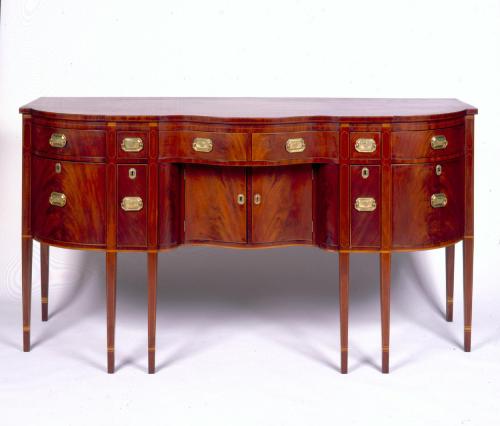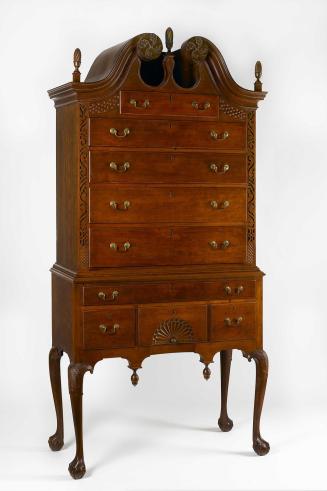Sideboard
Furniture MakerMade by
Benjamin Catlin Gillett
(American, 1783 - 1837)
Furniture MakerMade by
Aaron Chapin
(American, 1753 - 1838)
Original OwnerProbably originally owned by
Daniel Buck
(American, 1779 - 1860)
Date1805
MediumMahogany veneer and mahogany primary wood, light and dark wood inlay, eastern white pine and tulip poplar secondary wood, brass hardware
DimensionsPrimary Dimensions (overall height x width x depth): 41 1/2 x 78 3/16 x 28 9/16in. (105.4 x 198.6 x 72.5cm)
ClassificationsFurniture
Credit LineMuseum purchase, through a gift from Geoffrey S. Paul
Object number2002.100.0
DescriptionMahogany and mahogany veneer sideboard in the Federal, or early neoclassical, style. The sideboard has eight legs and a shaped front consisting of a serpentine center, flanked by a flat area, and then a quarter-round, or ovolo, section that curves back toward a flat area at each corner. The top has veneered front and side edges with two parallel light wood inlaid lines; a third parallel line of light wood inlay is applied to the front of the sideboard, about an inch below the top. The arrangement of the sideboard includes five drawers in line over a cabinet with two drawers flanked by two additional drawers; each drawer front and door conforms to the shaped front of the sideboard. The center drawer, with veneer and inlay to imitate two drawers, is over a recessed cabinet that is flanked by a vertical, quarter-round panel with figured mahogany veneer. This is flanked by a leg post at the front of the sideboard, a short narrow drawer over a tall, narrow bottle drawer, and a second leg post at the front of the sideboard only. This is flanked by a curved drawer over a deep, curved drawer, and a leg post at both the front and back corners of the sideboard. Each drawer and door, and the quarter-round figured panels, are veneered with figured mahogany and outlined on the drawer or door front with thin lines of light wood and dark wood inlay. Each leg post extends the full height of the case, and tapers below the case to form a slender foot. At the top of each leg post is a two-inch wide area of vertical light and dark wood inlaid lines. Below this are two light wood, inlaid vertical rectangles with quarter circles at each corner; the height of these two rectangles corresponds to the height of the drawers or cabinets to either side. A horizontal band of light and dark wood inlay is applied to the sideboard at the bottom front and side edges of the case; it is applied across the leg posts as well. Below this band, a pair of tapered light wood inlaid lines extends down the front of each leg to the ankle. A horizontal band of light and dark wood inlay is applied to the front and side edges of each leg, just above the plain foot. Hardware on the sideboard includes a stamped brass escutcheon with a bail pull at the center of each drawer; the top center drawer has two escutcheons. The lower, center cabinet doors each have a tall, rectangular, brass lock escutcheon with quarter round corners at the interior edge. A similar escutcheon is applied to the top center edge of the lower drawers. There is a latch on the interior right side of the left cabinet door. There is one working key for the right cabinet door only.
Condition: Small areas of veneer and inlay have been repaired or replaced on the front of the sideboard, specifically, at the bottom of the quarter-round panel to the left of the cabinet door and on the rail below the bottom left drawer. All the drawer bottoms have wood strips glued onto the back section, where they are nailed to the drawer backs. Several holes are drilled through the backboard. The sideboard has been refinished. Previous hardware holes have been filled in. The hardware is replaced; with both period and reproduction brasses.
Design and Construction Details:
Case Construction. The top is constructed of a single board that is reinforced on the underside by a frame. The front and side edges of the top are finished with veneer and inlay. The top is attached to the case with screws that are applied from below through the backboard, case sides, and rail. The backboard and sides are horizontally oriented and tenoned into the leg posts. The top rail is constructed of a single board with a shaped front edge that extends the full width of the case; it does not extend the full depth of the case. The board is dovetailed to the front corner leg posts and a block of wood that is immediately behind the post. This board is also shaped to accommodate the position of the leg posts. There is a full-depth, full-height vertical divider behind each of the four center legs. These dividers are tenoned through the backboard. The bottom of the case is constructed of two boards that extend the full width of the case, one in front and one in back. The board in front forms the bottom rail, and has a shaped and veneered front edge and extends back about half the depth of the case. The front board is screwed to the underside of the vertical dividers. The board in back is not as thick, and is nailed to the bottom of the backboard and sides. A single strip of wood is applied to the underside of the sideboard; it is screwed to the back edge of the center of the front board and to the bottom of the backboard.
Drawer Construction: The drawer divider consists of a single board that extends the full width of the case, much like the bottom and top rail at the front of the sideboard. The drawer runners and drawer guides are nailed to the vertical partitions or to the sides of the case, depending on their location. There is a full-depth, horzontal dust board below the top center drawer; this forms the top of the cabinet below. Vertical wood blocks are located at the back corners of each of the drawer housings; these act as drawer stops. Each of the drawer fronts are veneered and have a shaped or flat front, as is appropriate for their location on the sideboard. The drawer sides are flat on top. Each drawer bottom slides into grooves at the sides and front of the drawer, and is nailed at the back. Each bottle drawers has four vertical dividers; these are held in place with nails through the drawer sides.
NotesProvenance Note: Daniel Buck (1779-1860), a wealthy Wethersfield merchant married and acquired a large house on Grove Street in Hartford in 1805, the year in which the sideboard was made.Condition: Small areas of veneer and inlay have been repaired or replaced on the front of the sideboard, specifically, at the bottom of the quarter-round panel to the left of the cabinet door and on the rail below the bottom left drawer. All the drawer bottoms have wood strips glued onto the back section, where they are nailed to the drawer backs. Several holes are drilled through the backboard. The sideboard has been refinished. Previous hardware holes have been filled in. The hardware is replaced; with both period and reproduction brasses.
Design and Construction Details:
Case Construction. The top is constructed of a single board that is reinforced on the underside by a frame. The front and side edges of the top are finished with veneer and inlay. The top is attached to the case with screws that are applied from below through the backboard, case sides, and rail. The backboard and sides are horizontally oriented and tenoned into the leg posts. The top rail is constructed of a single board with a shaped front edge that extends the full width of the case; it does not extend the full depth of the case. The board is dovetailed to the front corner leg posts and a block of wood that is immediately behind the post. This board is also shaped to accommodate the position of the leg posts. There is a full-depth, full-height vertical divider behind each of the four center legs. These dividers are tenoned through the backboard. The bottom of the case is constructed of two boards that extend the full width of the case, one in front and one in back. The board in front forms the bottom rail, and has a shaped and veneered front edge and extends back about half the depth of the case. The front board is screwed to the underside of the vertical dividers. The board in back is not as thick, and is nailed to the bottom of the backboard and sides. A single strip of wood is applied to the underside of the sideboard; it is screwed to the back edge of the center of the front board and to the bottom of the backboard.
Drawer Construction: The drawer divider consists of a single board that extends the full width of the case, much like the bottom and top rail at the front of the sideboard. The drawer runners and drawer guides are nailed to the vertical partitions or to the sides of the case, depending on their location. There is a full-depth, horzontal dust board below the top center drawer; this forms the top of the cabinet below. Vertical wood blocks are located at the back corners of each of the drawer housings; these act as drawer stops. Each of the drawer fronts are veneered and have a shaped or flat front, as is appropriate for their location on the sideboard. The drawer sides are flat on top. Each drawer bottom slides into grooves at the sides and front of the drawer, and is nailed at the back. Each bottle drawers has four vertical dividers; these are held in place with nails through the drawer sides.
Status
Not on view








